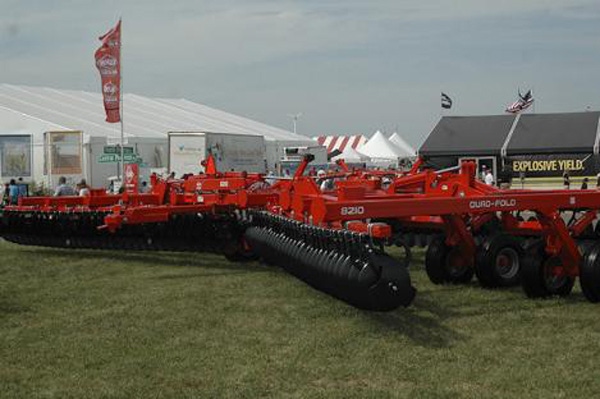April 13, 2014

It has been close to a decade since vertical tillage entered the vernacular on Midwest farms, nudging its way in the category of reduced-tillage farming. Although definitions vary, it is still one of the hottest topics in tillage and the most searched-for term on our website.
The practice, which gained favor when farmers were looking for a fast and effective way to handle crop residue, uses rotary blades to cut through and size the stalks and incorporate the material in the soil to jumpstart decomposition.
We asked three industry experts, each representing a different tillage manufacturer, to speak before farmers at the 2014 National Farm Machinery Show, answering your questions about design differences, brand selection, and usage.
Panelists:
Moderator: Scott McPheeters, Nebraska farmer and Farm Industry News field editor
Rob Zemenchik, Case IH marketing manager for tillage products
Curt Davis, marketing manager, Kuhn Krause
Jim Boak, National Sales Manager, Salford Farm Machinery
Q. How do you propose we make the switch from conventional tillage to VT if all we have is a standard chisel plow, disk, and field finisher?

Jim Boak, Salford
If you have chisel plow, you probably are doing a lot of what you are asking already. If you have a chisel plow with shovels, you’ll obviously want to change back to straight shovels. Vertical tillage is like no till. It is an assist to no-till. To make the transition, you have to spend some money. But if you look carefully at what you have, you can make a gradual transition. You don’t have to give up what you are doing because you are obviously successful, so don’t discount that. Take a look at what you have. Go to your local dealers, who are trained on how to make that decision.
RZ. VT does not operate in vacuum. Anytime you change something in the growing cycle, you must consider what took place in fall, whether it is no till, mulch till, or any other tillage system. With 200 bu. corn stand, you are talking about (check: 5 to 7 tons of residue/acre). If we process that down using some sort of machine in the fall, like you said a chisel plow, it must be compatible with conditions found in spring for us to consider VT. The combine shredding and spreading have to be considered and watched as well as what comes out the back with the fall tillage pass. So customers told me they need a sequential approach, and that has implications for the planter also.
Q. If I make part of the transition, since I have to spend money for all tools, am I going to ruin what I’ve tried to do?
JB. No. You don’t lose anything by easing into it slowly. VT isn’t the complete answer. I wish it was. But it isn’t. It is a combination of tools. So start with one, and slowly transition over. You may never completely convert over. You may have a hybrid operation, with a little bit of conventional and a little bit of VT. It’s a mistake to think that we can do everything with one pass. We are just kidding ourselves. Mother nature and soils don’t always cooperate.
Q. Generally speaking, does VT involve concavity or no concavity discs or coulters? Sweep chisels? Harrows or baskets? What makes up your typical VT machine?
JB: The idea is to keep all earth engaging tools running straight. You don’t want to move all of the soil. You want to loosen it and let your planting tools finish the job. You want to try to avoid sweep chisels. The reason VT gained ground--more than fuel savings and residue mixing—is that we almost eliminated the secondary density layer below the soil. When seed hits higher-density ground, it will start to grow sideways. Four years out of five, especially in this weather, you will see that happen. You should just weaken the ground, not loosen it, so your planter will do a better job planting. A tougher root system is where VT, especially in tough years, outshines conventional.
Q. My understanding of VT, is you slice the soil to incorporate nutrients, aerate it, break it up and loosen it and incorporate the residue but not destroy the ecosystem. How does each of your machines do that? Are you running coulters? Wave coulters? Offset coulters? How do you take the soil and give it a side fracture because obviously running a straight blade will break through the trash and cut through the soil but won’t move it?

Curt Davis, Kuhn Krause
On the Excelerator, we use a 34-flute, specialized blade with a shallow, ¼-in. concavity. You can angle the blade or put some angle into the gang itself from 1 to 5 degrees to move the soil and start the mixing process and the residue breakdown but not destroy the ecosystem you want to create. With VT you are trying to till no deeper than what you are going to plant the seed, and that is very shallow. So you want a machine that can maintain that shallow cut across the width of machine at high speeds, at 10 mph, and set the stage for young root development. You want to break down that residue, get it into organic matter for use in next year’s crop but also to help control wind and water erosion by anchoring the residue into the soil. The blades on our machine and the star wheel treader take the residue and anchor it in the looser surface soil to set the stage for the VT operation to be successful.

Rob Zemenchik, Case IH
As far as the soil dynamics and how we manage the soil, it is the lateral movement, whether created by flutes or a slight angle of the blade, that provides the leveling component so that shallow wheel tracks and other things are no longer in the seedbed. If we are going to run at faster planter speeds, we have to be sure we have the kind of seedbeds to accommodate it or we will have planter row-unit bounce or doubles or triples and other stand emergence issues. So VT also sets the stage for us to work together with other productivity developments you are seeing in the marketplace.
Q. Is spring too late to do VT? Or is fall the most optimal time? And, is it going to help out with a slug problem this year?
RZ. Initially we thought VT would be mostly a spring practice. Turns out, though, VT is done equally as much in the fall. Why? Because mechanical processing can help harness the remaining heat units post-harvest needed to begin decomposition of the stalks. I’m not anti- no-till. I’m saying that with (check: 5 to 7 tons of corn residue/acre), a little soil on that residue starts to inoculate that substrate or stalks to begin that decomposition and cycle the potassium and phosphorous reserves out of the stalks and down into the row in spring. So that is why people are considering chopping corn heads or fall VT passes, or other processes in fall, especially in corn on corn rotations.
CD. In spring, no, you are not too late. Fall application of VT will accentuate what happens in spring. But you can still do a good job with VT in spring and set yourself up for a good growing season.
Regarding the slug problem, sometimes that can be alleviated by VT by introducing air into the topsoil, which starts to reduce the moisture they are really liking. It also starts to break down some of the food they are after, which is the residue. So it can help you. Will it eliminate it? Maybe not. But it will help.
Q. Is VT tailored to a certain type of soil structure?
CD: As I was alluding to earlier, VT addresses more than just the top 2 in. of soil. It also sets the stage for a deeper soil profile to ensure there is nothing there to impede root development. Roots can grow as deep as 8 to 12 in. or deeper. If there is a compaction layer underneath the shallow topsoil, VT also serves as an inline ripper by making sure there are fracture zones in the subsoil to allow for good root development, water infiltration and air diffusion in that soil. The subsoil and root system need air just as much as the plant does. So VT must ensure the entire profile is set properly so that the very shallow VT has success in the later part of the cropping cycle.
RZ: The audience member makes a very good point. There are over 16,000 soil types according to the U.S. Soil Survey. Many of those exist in the same field. So underlying conditions must be considered also, and not just the top 2 to 3 in. of soil. They have to work in concert. And what a lot of growers have found successful is to look at the porosity of the soil and to consider non-inverting sub-soiling ahead of VT to reestablish the pore space deeper down so that after planting, roots can proliferate and can take advantage of not just the seedbed but those underlying subsoil improvements we have made, both in terms of the physical structure of soil and the pH, liming and fertility.
Q-What is the optimum speed for these machines? Would you be better off with a 50-ft machine at 10 mph, a 40 ft. machine at 12 mph. And what is the optimal blade configuration?
JB. That also varies by soil type. We like to consult with our dealers to answer that. It seems like the range is anywhere from 8 to 12 mph. A lot of things happen at 12 mph, and you have to be conscious of what is going on around you, especially at 40 and 50 ft. working widths. Every tool has an optimal speed and they are not all the same. We can recommend what speed based on that tool.
In the case of a chisel plow, we would recommend the 8-wave all the way through the machine. Basically I would sell him a field cultivator. If you have already made the full transition into VT, most often, depending on soil type, we would recommend the 13-wave or a combination of the two so that you get best of both worlds.
Q. Would the bigger blade cause more fracturing?
JB. Ironically, not always, and it is soil-type related to some degree. We will find fracturing below the blade more frequently with the 13-flute blade than the 8-flute blade, and the straighter the blade, the more likely that is to happen. So the more flutes you have, the more vibration, and the more density reduction.
CD. With the Excalibur blade on the Excelerator, we use the 32-flute design, so it is different than most on the market. What we found in our testing is, if we are using it as a seedbed preparation machine, we want to have a small clod size to get good seed-to-soil contact. Where we get to 32 flutes, the smaller the flute, the smaller the clod, and the speed to address that is going to be customer preference.
But a typical range of operation on our machine is from 7 to 10 mph. Some run faster, others run slower. It depends on soil type, your conditions, whether you have rocks, all has to be taken into account. But typically we suggest 8 to 10 mph because it provides some action needed to generate that small clod size and get the best seed to soil contact in the seedbed.
RZ. Our blade is the new VT wave blade we are showing today. We found that at 20-in. in diameter, the dynamics of those smaller flutes work to keep that soil clod size at optimum seedbed conditions in most soil types. As we went to larger blades with our geometry, the rpms were too slow to provide that fracture. It is true that as you reach 7 to 9 mph, the draft requirement in that envelope is substantial. At half the speed, you get a lot less draft, but every machine has a design envelope. Ours is 7 to 9 mph. Another machine’s might be 8 to 10. When you operate outside that envelope, either you don’t get the leveling you want or you have durability issues. So we encourage people to stay within those envelopes.
Q. How well do your machines work on cover crops like rye?
JB. That is hard to answer because there are so many different ways of doing it. And those who grow cover crops have different expectations. So we provide a range of tools to help you manage it your way. If you are an organic farmer who wants to incorporate the residues rather than use herbicides, then you have to switch to a different tool. If you are able to use burndowns, then you want to get the material brown, and then you can, with very minimal tillage and minimal soil movement, plant right into the cover crop. We as manufacturers have to understand what your goals and challenges are before we can recommend a tool.
CD. In term of cover crops, we have had several customers incorporate cover crops, whether it be radish or rye, for the fall and winter growth to establish those cover crops. And it is that very shallow incorporation that many of those cover crops are looking for. The Excelerator works very well in that regard because of its ability to control that depth in very shallow operations across the width of the machine.
RZ. over crops, whether they be legumes or grass-based species, if they are green, and that is goal of grower, we would have to have the ability to incorporate at the appropriate level--not too shallow and not too deep--so all of the VT machines have to be adjustable within that range, from 0 to 3 in., to get the output you want. and not just push it over. And if there is a need for some incorporation you can do that also. And if it is a crop that has been treated and killed with roundup or something else, that also has to be built into the machine. So with cover crops, we have green and growing vs. dessicated, and these machines have it all. So clearance becomes a premium. The residue has to get through the machine uniformly because the drill or planter that follows cannot deal with bunny hutches and mass accumulations in the field.
Like what you’re reading? Subscribe to Farm Industry News Now e-newsletter to get the latest news and more straight to your inbox twice weekly.
About the Author(s)
You May Also Like




